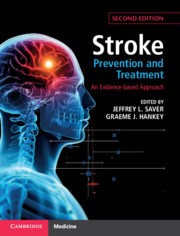Book contents
- Stroke Prevention and Treatment
- Stroke Prevention and Treatment
- Copyright page
- Dedication
- Contents
- Contributors
- Preface
- Part I Foundations
- Chapter 1 Stroke: The Size of the Problem
- Chapter 2 Understanding Evidence
- Part II Systems of Care
- Part III Acute Treatment of Ischaemic Stroke and Transient Ischaemic Attack
- Part IV Acute Treatment of Haemorrhagic Stroke
- Part V Prevention
- Part VI Stroke Rehabilitation and Recovery
- Index
- References
Chapter 1 - Stroke: The Size of the Problem
from Part I - Foundations
Published online by Cambridge University Press: 15 December 2020
- Stroke Prevention and Treatment
- Stroke Prevention and Treatment
- Copyright page
- Dedication
- Contents
- Contributors
- Preface
- Part I Foundations
- Chapter 1 Stroke: The Size of the Problem
- Chapter 2 Understanding Evidence
- Part II Systems of Care
- Part III Acute Treatment of Ischaemic Stroke and Transient Ischaemic Attack
- Part IV Acute Treatment of Haemorrhagic Stroke
- Part V Prevention
- Part VI Stroke Rehabilitation and Recovery
- Index
- References
Summary
In the year 2010, an estimated 16.9 million strokes occurred worldwide at an incidence rate of 258 per 100,000 persons per year. Approximately 70% of these strokes occurred in low- and middle-income countries. The 16.9 million incident strokes were added to a pool of 33 million prevalent stroke survivors. There were 5.9 million deaths and 102 million disability-adjusted life-years (DALYs) lost due to stroke in 2010, making stroke the second leading cause of death and the third leading cause of DALYs worldwide. In the preceding two decades, between 1990 and 2010, the incidence rate of stroke remained stable but the absolute number of incident strokes increased by 68%, the prevalence rate increased modestly yet the absolute number of stroke survivors nearly doubled, the rate of DALYs lost due to stroke decreased but the absolute number of DALYs lost increased by 12%, and the mortality rate fell but the absolute number of stroke-related deaths increased by 26%. Most of the burden of stroke is in low-income and middle-income countries, which bear 63% of incident ischaemic strokes and 80% of haemorrhagic strokes. The average age of incident ischaemic and haemorrhagic strokes was 6 years younger in low- and middle– than high–income countries.
Keywords
- Type
- Chapter
- Information
- Stroke Prevention and TreatmentAn Evidence-based Approach, pp. 1 - 9Publisher: Cambridge University PressPrint publication year: 2020



